

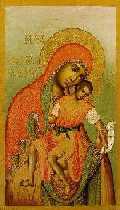
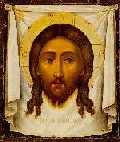
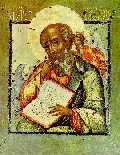
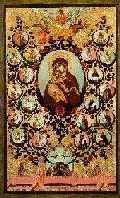
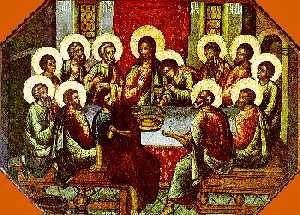
Simon Ushakov: First row, from left to right: The Virgin Eleousa of Kykkos (1668), Christ Acheiropoietos (Mandylion) (1660s), St. John the Theologian (1673), Apotheosis of the Virgin of Vladimir, otherwise known as The Genealogical Tree of the Muscovite State (1668). Second row: The Last Supper (1685).
Active in Moscow, Simon Ushakov combined the traditional style of Russian icon painters with realistic details of Western European art. He became a member of the "Kremlin Armory" workshops which was a unique "academy" of the arts. There, together with his friend Iosif Vladimirov, he created a new type of art, which was more rational and less spiritual. They managed to create a more three-dimensional type of icon using chiaroscuro for modeling the faces of their subjects. Nevertheless, Ushakov also preserved the traditional technique of applying paint, from light to dark (characteristic of icon painting). He also never traded tempera for oil paint. In order to increase the sense of depth, Ushakov's landscapes and architectural motifs were borrowed from Western European art. He invited Western masters to Russia to promote and teach the different styles of painting. In 1644 he became the head of the studio which he directed until his death in 1686. At twenty-two, he was appointed a court painter. One can notice a marked duality in Ushakov. On the one hand he was an iconographer who respected and honored the traditional canons of art, on the other he was an innovator who desperately searched for new ways of artistic expression. Moreover, Ushakov was very versatile. His talent found an outlet in his work in silver shops, where he designed both jewelry and weapons. He became a famous engraver and founded his own workshop. His fame as an iconographer was established around mid-century. Most notable were his portraits of Christ, rendered in cool, pale colors. They reflect his fascination with the human face. Ushakov was an artist who helped Russian painters to make the transition to a more secular art. Some of his greatest contributions included the exterior frescoes in the Dormition Cathedral (Uspenskii Sobor) of the Moscow Kremlin. In 1664 he was officially appointed the first "iconographer of the Tsar," and worked on portraits of the Tsar (parsunas). He is also remembered for his version of Andrey Rublev's Holy Trinity and for designing a manual of icon-painting (podlinnik). Examples of his work can be found in the Tretyakov Gallery in Moscow. [S.C.]
[Sources: Art Treasures in Russia, Moscow: Treasures and Traditions, Ivanov].
